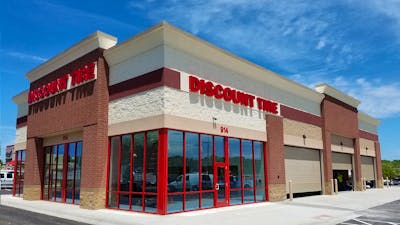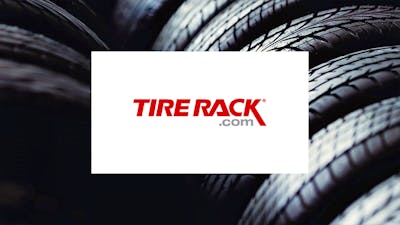Best Tires for the Ford Edge
Here at Car Talk, we are huge fans of the all-season capabilities of the mid-sized crossover, so we shall stay the course with all-season tires. In general, as wheel diameters increase, so do the performance capabilities and focus of these tires.
Get the Best Deals on Tires
Top Replacement Tires for Ford Edge
Conversely, a wider selection is available in the 18” lineup and thus allows for an increased range of capabilities.
You're going to see a recurring theme here, this is by design. The Goldilocks of tires is where you have reached that point of diminishing returns. While you can spend more money and gain in overall tire characteristics, your return on investment decreases after that point. In the highly-focused 21-inch tire range, you will find many similar tire brands and models with exceedingly minute differences that yield a large price differential.
Below are our picks for good tires for each trim level, to help you make the best decision for your Ford Edge.
18-inch Tires for Ford Edge SE, SEL and Titanium
- Budget: Sumitomo HTR A/S PO3 - This entry-level tire is a good starting point. Sumitomo has done a good job of combining a good performance rating with good traction, temperature and wear specs in a low-cost tire from a respected brand. This is echoed through many of the wheel diameters available on the Edge.
- Moderately Priced: Continental CrossContact LX25 - A highly acclaimed tire that is hard to beat. This Continental provides all of the attributes one looks for in a tire - good performance across the board while providing a lasting tread that is quiet and comfortable.
- Cost-No-Object: Michelin Defender LTX M/S - A traditionally light-duty truck tire is put to good use here. The LTX moniker has been around for decades and for good reason - Michelin has managed to pack impressively long life in a tire that provides excellent traction in all conditions. The pain of price is lessened as you pound the pavement year after year in comfort and confidence.
19-inch Tires for Ford Edge Titanium
- Budget: Sumitomo HTR A/S PO3 - Again, a venerable, low-cost choice, this time in the 19-inch flavor. Comparable ratings to more expensive tires, this Sumitomo will provide many miles of smiles.
- Moderately Priced: Continental CrossContact LX25 - Smooth and quiet performance in all conditions - a tire that will fit your needs without breaking the bank.
- Cost-No-Object: Michelin CrossClimate2 - A newcomer from Michelin, yet it has already made the best of what the Michelin name brings to the table. A tire designed for everyday use with excellent traction in all conditions, including light snow.
20-inch Tires for Ford Edge ST and Titanium
- Budget: Sumitomo HTR A/S PO3 - The Sumitomo remains a solid choice here - solid all-around performance baked in, this is a high-value tire. As the diameters of these tires become larger, so do their prices. When value is the utmost factor in choosing a tire, this one is hard to beat.
- Moderately Priced: Continental CrossContact LX25 - By providing long-lasting treadwear with traction in the dry, in the wet and even in light snow, the CrossContact LX25 is a sensible choice when the need for a great tires meets the needs to balance your checkbook.
- Cost-No-Object: Michelin Primacy Tour A/S - Designed for year-round use in all conditions - this tire handles whatever you throw at it with aplomb. Quiet and comfortable performance in this premium tire makes the drive a pleasure.
21-inch Tires for Ford Edge ST
- Budget: Pirelli Scorpion Verde All Season - It’s hard to call this OE tire budget, but in this class, Ford got it right providing a good tire at the best price point it could (or is it because Ford made this an OE tire that it drove the cost down through volume?)
- Moderately Priced: Continental CrossContact LX Sport - A confidence-inspiring tire which will allow the more sporting side of both you and your Edge to come out and play. You’ll be able to better explore the edges of adhesion comfortably through the technology of construction and materials used in the CrossContact LX Sport.
- Cost-No-Object: Michelin Pilot Sport All Season 4 - This is Michelin's newest entry in a long lineup of high-performance all-season tires. Each generation has improved significantly over the last and you reap the benefits of the decades of development. You get what you pay for with this latest iteration of the rubber donut concoction.
What Tires Are On My Ford Edge?
The 2016 Ford Edge is available in multiple trim levels, some of which allow for multiple wheel diameter choices. The most popular tire size - P245/60R18 is used in the SE, SEL, and Titanium trims. A P245/50R20 is fitted to both the ST and Titanium trims. A somewhat oddball tire size is the P245/55R19 on the Titanium and finally the largest tire, the P265/40R21 is available exclusively on the ST.
18-inch tires are made by various manufacturers (due to their popularity) however the 19-inch options are Hankook Ventus S1 Noble2 while the 20-inch and 21-inch are Pirelli Scorpion Verde All Seasons.
When Should You Replace Tires?
There are three main reasons why you will need to replace your tires:
The tread is too heavily worn and at the end of its usable life. Excessive age resulting in dry rot (the appearance of small surface cracks much like those in a dry, arid landscape) Physical damage. Tires are tough, but they’re still made primarily of rubber.
The first is easily identifiable through the tread wear indicators molded into the large circumferential voids. Once the tread is even with these wear bars, there is insufficient tread left to avoid hydroplaning (the tread leaving the surface of the road due to water) and definitely too low to help in light snow.
Regarding age, tires are more like milk than wine - they do have a best-if-used-by date. Generally, this is around 5 years, but once you can see fine to medium cracks in the sidewall and/or tread of the tire, it’s time to replace. Heavy cracking that allows you to see the inner tire construction such as the fabric cord is a strong indicator the tires are well past their prime.
Finally, damage from road hazards: We’ve all experienced this and if you haven’t, you will. Nails, screws, potholes, raised manhole covers and steel plates, curbs, etc. Alex, “What are hazards to the expensive rubber donuts on our cars?”. Some minor punctures in the tread can be repaired, but more significant damage to the tread and any damage to the sidewall will necessitate the replacement of your tire(s).
Why Not Replace With Original Equipment Tires?
There is nothing wrong with the OE tires that come equipped on your Edge, but there is a compromise made between cost, availability, performance, and NVH (noise/vibration/harshness) characteristics from the factory. A choice to replace tires with non-original tires will depend upon what do you like and dislike about your current tires and what would you like to achieve? These factors will help shape your decision and help you decide upon what tire is best for you.
Changing Ford Edge Tire Sizes
Once you’ve made your decision about which tire you’re going to go with, you have yet another option - whether or not you’re going to deviate from the factory tire dimensions. This is not something that can be taken lightly as changing the tire size can have adverse effects on the vehicle’s driving dynamics.
Overall, you will want to try and keep the overall circumference of the tire the same. There are many different complex systems that depend upon the rotational speed of your tires and your tire size can greatly affect this speed. Systems like TPMS, ABS, your speedometer and odometer, traction/stability control, transmission, and more depend upon this speed input to make decisions and can alter their operation. Due diligence upon your part is crucial if you are to properly change the tire dimensions and achieve your desired outcome.
You may want to change to a narrower tire to achieve better traction. This goes against what most people will think, but as the contact patch (the portion of the tire that meets the road surface) is decreased, the pressure is increased as the weight of the vehicle remains the same. Under dry conditions, this will not yield better traction. But in heavy snow conditions, this narrower tire will allow the tire to dig down through the snow and make contact with the road surface and that is what will help you maintain traction and thus control of your vehicle. Take this example to an extreme and imagine a pizza cutter vs a balloon-like beach tire traveling on snow and you’ll get the idea.
You may want a wider tire for aesthetics or for better traction in dry weather. In this case, a properly sized wider tire will get you more traction - in the dry. It may increase traction in the wet provided the tread can still evacuate enough water to prevent hydroplaning (there’s that word again!).
In either case, more rubber hitting the road is better for you. If your primary reason is the look, a fat, steam-roller of a tire is what you’re probably after. Be careful there too as alignment angles can be changed for the worse.
If you’re careful with your changes, you can get the performance and look you’re after!
Tire Sizes By Year
| Year | Trim | Size |
|---|
Shop Tires Online and Save
Online tire prices are usually less than in store

Ford Edge Tire FAQ
- What are the best tires for my Ford Edge?
It depends largely on your budget and your requirements. For budget-minded shoppers, the Sumitomo HTR A/S PO3 is a very good choice. Moving up the scale, Continental has a firm grasp on the middle ground, providing very good performance for a good price. Finally, the King of the Mountain, Michelin still occupies the top spots in all categories.
- What brand of tires does Ford use on the Edge?
Ford uses a range of tires on the Edge, depending on the trim level, and sometimes the day of the week. On the Edge ST, for example, your vehicle could’ve come with Hankook Ventus S1 Noble 2s, Continental CrossContact LX Sport, or Pirelli Scorpion Verde all-seasons.
- What is the best Ford Edge tire pressure?
The optimal tire pressure that should always be maintained within your tires will be displayed in a placard inside the driver door jamb. Follow factory recommendations and always remember that tire pressure will fluctuate with air temperature. This is not only affected by the ambient temperature outside but also the very act of driving will generate heat within the tire itself. Keep a close eye on your tire pressure - your tires will thank you (well, not literally). Tire pressure is an oft-overlooked aspect of tires that has such a large impact upon ride quality, tire longevity, overall performance and ultimately safety.
- How often should I rotate my Edge’s tires?
In general, rotating tires at every oil change is a good starting point. Should the tread depth differ significantly (more than 2 or 3mm) from front to rear, have your tires rotated. This will help extend the tread life as well as help minimize adverse wear effects from driving habits, conditions, and alignment deflection.
- What is the best Edge tire change kit?
The one provided in your vehicle will work and is already securely mounted and out of the way. You may want to augment that kit with gloves and wipes, but the kit that you know how to use is going to be the best. Practice under good conditions how to change a tire to familiarize yourself with not only the process but the tools as well.













